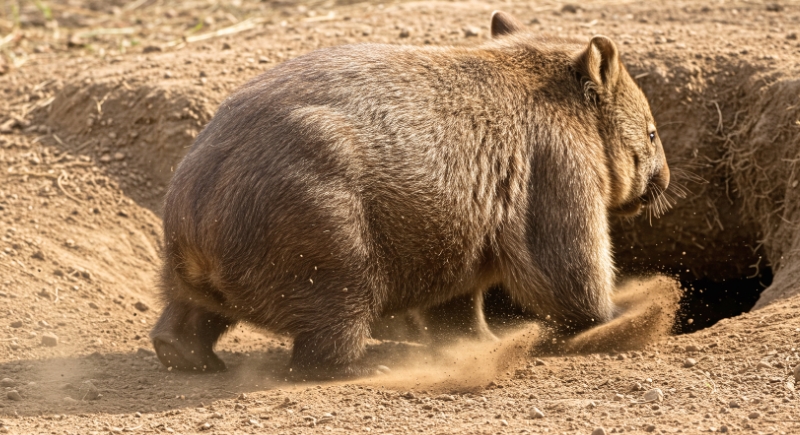Wombats Have the Most Bizarre Defense Mechanism in Nature
One of Australia’s most endearing animals is also one of its toughest. Wombats, the stocky, short-legged diggers that resemble plush toys with power tools, rely on a defense that sounds absurd until you see how effective it is: their backsides. A wombat’s rump is packed with cartilage and thick bone, with few nerve endings, so it can take blows without much reaction.
When predators like foxes or dingoes give chase, the wombat bolts into its burrow and seals the entrance with its fortified rear. The tough barrier keeps its soft underbelly and head safe inside, while the attacker is left outside with nowhere to go.
If a predator keeps pushing, the wombat can thrust upward, pinning the intruder against the tunnel’s ceiling. Some reports even claim foxes have been found with crushed skulls near burrow openings, though researchers such as Alyce Swinbourne from the University of Adelaide note the evidence isn’t conclusive. Either way, it’s clear that few creatures risk testing that defense twice.
Built Like A Tank, Acts Like One Too

Image via Stock Dignity/tedwip
Wombats might look slow and cuddly, but they’re all business when it comes to survival. These burrowers weigh up to 80 pounds, and their bony butts can handle kicks, bites, and even full-on tackles.
Swinbourne describes their rear ends as “hardy rumps,” and for good reason. They’ve been seen lifting other wombats off the ground during fights, using pure hind-quarter strength. The design also helps with digging. Their flat, muscular bodies are perfect for tunneling through tough soil, turning their homes into near-fortresses.
And while they’re not likely to pick a fight, wombats know how to end one. An 18-pound fox versus a 45-pound wombat isn’t much of a contest. Predators quickly learn that chasing one is more effort than it’s worth. Still, wombats have a social side to their tough exterior. Southern hairy-nosed wombats, one of the more sociable types, use their rear ends for more than protection, using them to bond, play, and even flirt.
Romance, Wombat-Style
If you thought human dating was complicated, wait until you hear about wombats. Their courtship involves biting each other’s butts. Swinbourne explains that a female might nip a male on the rear and run off, starting a game of chase that eventually leads to mating. It’s rowdy, loud, and often leaves tufts of fur scattered everywhere, but it’s all part of the ritual. Wombat love may not be gentle, but it gets the job done.
Researchers at the University of Queensland are even studying these behaviors to help protect endangered wombat populations. Understanding how wombats bond, flirt, and mate could improve artificial insemination programs and boost their numbers in the wild. As odd as it sounds, that “love bite on a hairy bum” might just be the key to saving a species.
Nature’s Oddest Engineer
Just when you think wombats have revealed all their quirks, there’s another surprise: they produce cube-shaped droppings, roughly 80 to 100 each night. The geometric design keeps the pellets from rolling away, a handy trait for marking territory and signaling other wombats. It’s less about bathroom habits and more about communication.
Beneath their soft, rounded look is an animal built for resilience. From their reinforced rears to their precise piles of cubes, wombats turn odd biology into a survival strategy. Every feature, from cartilage armor to blocky poop, speaks to a creature that thrives by doing things its own peculiar way.